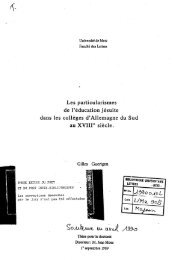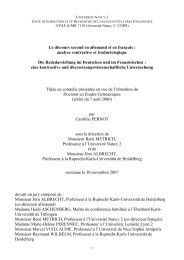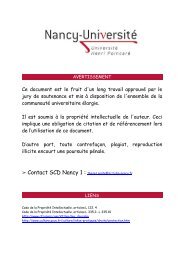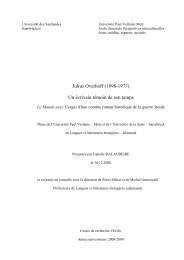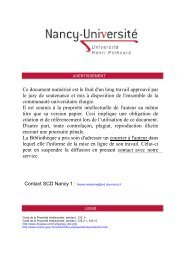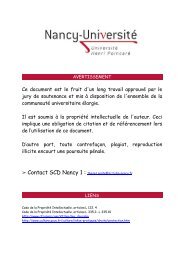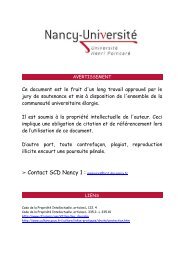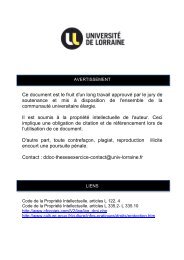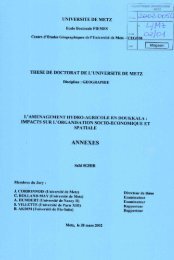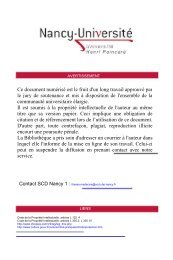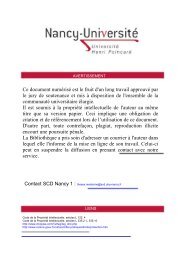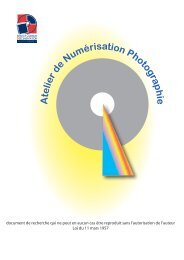Ce document est le fruit d'un long travail approuvé par le jury de ...
Ce document est le fruit d'un long travail approuvé par le jury de ...
Ce document est le fruit d'un long travail approuvé par le jury de ...
You also want an ePaper? Increase the reach of your titles
YUMPU automatically turns print PDFs into web optimized ePapers that Google loves.
Le titane se présente sous <strong>de</strong>ux formes allotropiques : ici, <strong>de</strong>ux structures cristallines<br />
différentes : alpha et beta.<br />
En <strong>de</strong>ssous <strong>de</strong> 882°C, <strong>le</strong> titane a une structure hexagona<strong>le</strong> compacte : <strong>le</strong> titane alpha.<br />
Au-<strong>de</strong>ssus <strong>de</strong> 882 °C, <strong>le</strong> titane a une structure cubique centrée : <strong>le</strong> titane beta.<br />
Le titane peut éga<strong>le</strong>ment se présenter sous forme d’alliages. Selon <strong>le</strong>s éléments d’additions<br />
possib<strong>le</strong>s au titane, on distingue <strong>le</strong>s éléments alphagènes qui favorisent la structure<br />
hexagona<strong>le</strong> : Al, B, C, O2, N2 ; et <strong>le</strong>s éléments betagènes qui favorisent la structure cubique :<br />
Mo, Va, Nb, Fe, Cr.<br />
<strong>Ce</strong>rtains éléments d’additions sont considérés comme neutres tel que <strong>le</strong> zirconium ou encore<br />
l’étain.<br />
Les alliages beta se sou<strong>de</strong>nt et s’usinent plus faci<strong>le</strong>ment, ce qui <strong>est</strong> intéressant pour un usage<br />
<strong>de</strong>ntaire.<br />
Il existe éga<strong>le</strong>ment <strong>de</strong>s alliages à structures mixtes : alpha+beta. Ils sont plus résistants que <strong>le</strong>s<br />
précé<strong>de</strong>nts, et s’usinent plus faci<strong>le</strong>ment que <strong>le</strong>s alliages alpha.<br />
Parmi ces alliages à structure mixte, on trouve <strong>le</strong> TA6V4 (fig. 40) (6% d’aluminium et 4% <strong>de</strong><br />
vanadium), mais aussi <strong>le</strong> titane-palladium, <strong>le</strong> titane-cuivre-nickel, ou encore <strong>le</strong> nickel-titane<br />
(utilisé en orthodontie ou en endodontie).<br />
Fig. 40 : Modification <strong>de</strong>s propriétés mécaniques du titane « commercia<strong>le</strong>ment pur » <strong>par</strong> <strong>le</strong>s<br />
éléments d’addition (D’après Wang, 1996). (48)<br />
Il existe donc différentes combinaisons possib<strong>le</strong>s pour <strong>le</strong> titane et donc, autant d’indications<br />
en fonction <strong>de</strong>s propriétés relatives du titane et <strong>de</strong> ses indications (fig. 41).<br />
Fig. 41 : Piliers implantaires en titane (Atlantis, Astra) avant et après la sé<strong>par</strong>ation du cylindre<br />
<strong>de</strong> titane dans <strong>le</strong>quel il a été usiné. (106)<br />
<br />
52



